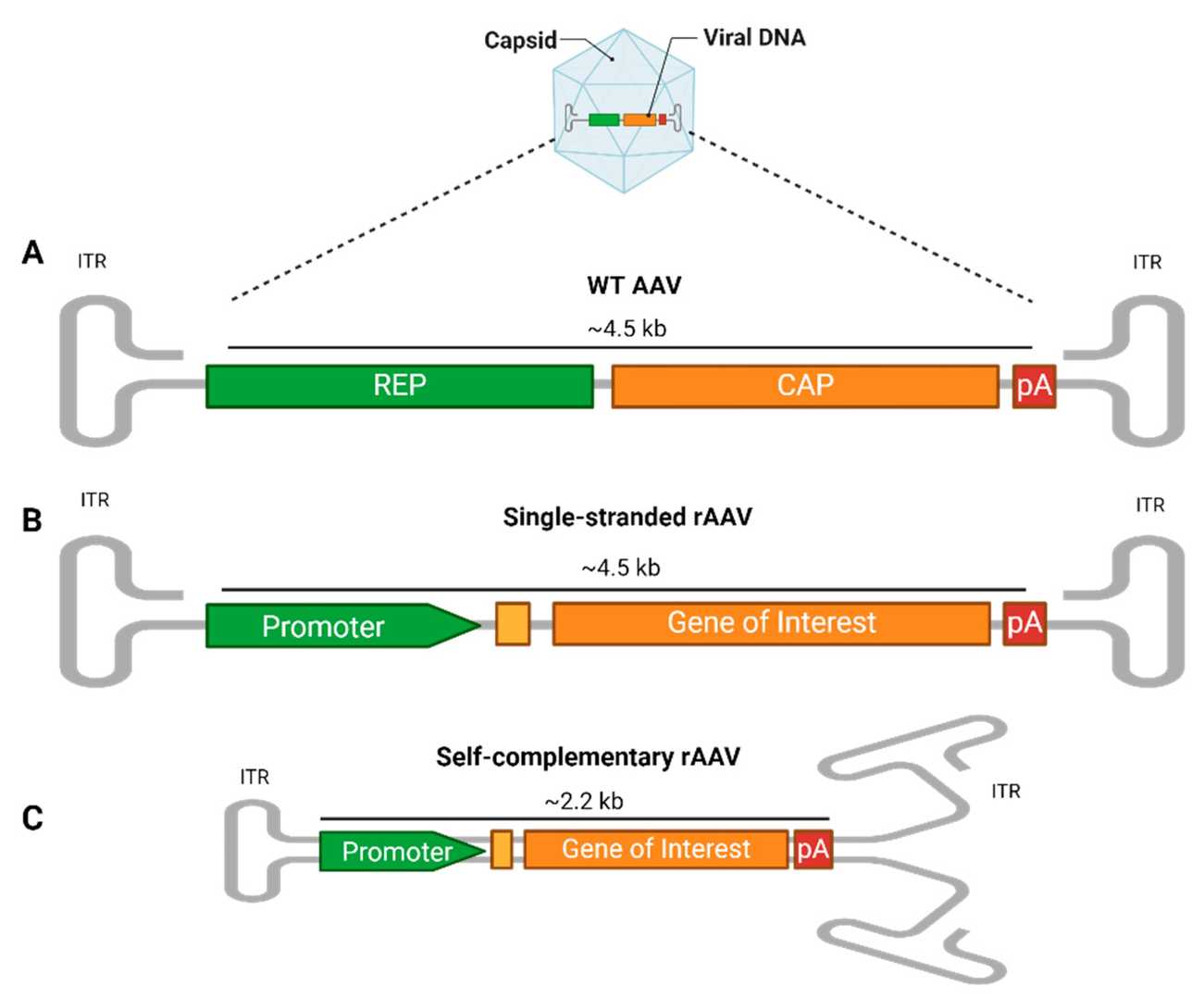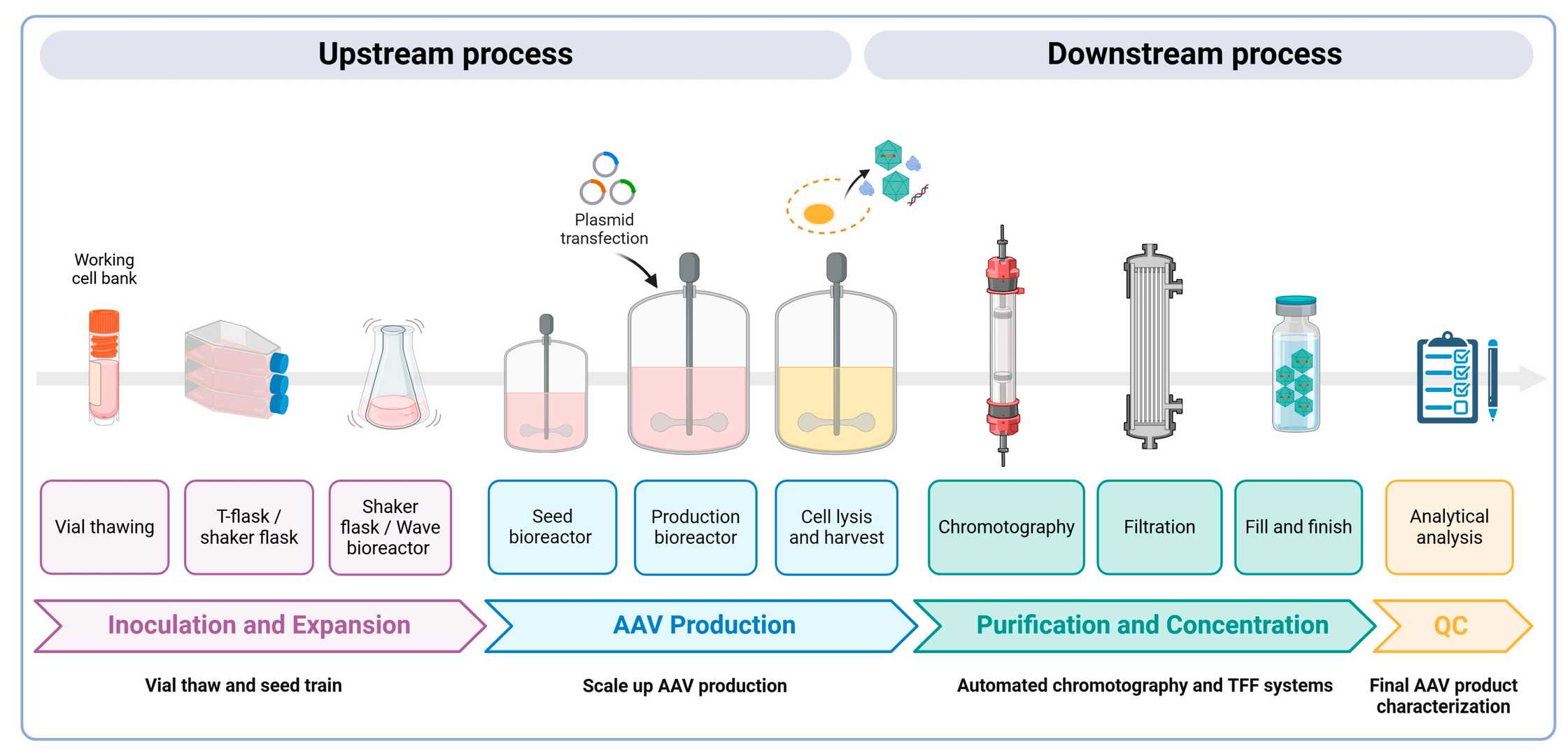Custom Adeno-associated Virus Vector Production Service
Introduction
Creative Biolabs' Custom Adeno-associated Virus Vector Production Service accelerates gene therapy research by offering advanced viral vector engineering and robust manufacturing. We provide high-concentration, high-quality, bespoke AAV vectors customized to particular requirements, surmounting production obstacles. Functionally validated and precisely engineered, our vectors ensure reliable gene delivery for consistent, reproducible results in gene therapy and research projects.
Custom Adeno-associated Virus Vector Production Service
 Fig.1 AAV vector constructs, including wild type (WT) AAV, single-stranded recombinant AAV (rAAV), and self-complementary rAAV (scAAV).1
Fig.1 AAV vector constructs, including wild type (WT) AAV, single-stranded recombinant AAV (rAAV), and self-complementary rAAV (scAAV).1
Adeno-associated viruses (AAVs) are small, non-enveloped viruses that belong to the Parvoviridae family. They are naturally replication-defective, requiring co-infection with a helper virus (like adenovirus or herpes simplex virus) to replicate. In gene therapy applications, the viral genes are removed and replaced with a therapeutic gene, making the AAV vector a safe and efficient delivery system that does not integrate into the host genome, minimizing the risk of insertional mutagenesis. Their diverse serotypes offer distinct tropisms, allowing for targeted gene delivery to specific tissues or cell types, which is crucial for various therapeutic applications.
 Fig.2 Schematic of the upstream and downstream processes in the preparation of adeno-associated virus.1
Fig.2 Schematic of the upstream and downstream processes in the preparation of adeno-associated virus.1
-
Upstream Process
-
Cell Expansion & Bioreactor Inoculation
Cells are propagated and transferred to a 50–200 L production bioreactor based on the required AAV scale. -
Triple Plasmid Co-transfection
A three-plasmid system (transgene plasmid, packaging plasmid [Rep/Cap], and helper plasmid) is co-transfected to drive AAV vector assembly. -
Cell Culture & Viral Production
Post-transfection, cells are cultured for several days to express and assemble AAV vectors (both genome-containing full capsids and empty capsids). -
Cell Lysis & Virus Release
Cells are lysed (via freeze-thaw, enzymatic, or chemical methods) to release intracellular AAV vectors and cellular components.
-
Cell Expansion & Bioreactor Inoculation
-
Downstream Process
-
Affinity Chromatography & Ion Exchange Purification
Affinity chromatography (e.g., AVB Sepharose) and ion exchange chromatography separate full AAV capsids from empty capsids and impurities to enhance purity. -
Tangential Flow Filtration (TFF)
TFF is used for vector concentration, buffer exchange, and sterility maintenance. -
Viral Particle Characterization & QC
Final products undergo testing for viral genome titer, purity (full/empty capsid ratio), and stability to meet clinical-grade AAV standards. -
Formulation & Packaging
Qualified AAV vectors are dispensed into vials for final packaging.
-
Affinity Chromatography & Ion Exchange Purification
-
Quality Control
Rigorous quality control (QC) is essential to ensure the safety, purity, potency, and consistency of AAV vectors. Comprehensive QC measures include:
- Viral Genome Titer (VG/mL)
- Physical Titer (VP/mL)
- Purity
- Sterility
- Potency/Infectivity
- Stability
[Discover How We Can Help - Request a Consultation]
What We Can Offer
At Creative Biolabs, our Custom Adeno-associated Virus Vector Production Service is designed to be your comprehensive solution for high-quality gene therapy research. We offer:
[Experience the Creative Biolabs Advantage - Get a Quote Today]
FAQs
Q1: In the process of AAV vector production, how can to improve the efficiency and consistency of co-transfection of three plasmids by optimizing transfection conditions?
A: In AAV vector production, optimization of triple plasmid co-transfection conditions can improve efficiency. Secondly, transfection reagents such as PEI (2-3:1 ratio) or Lipofectamine were selected as needed. Finally, ethanol purification and spectrophotometric quantification were used to ensure the consistent purity/concentration of plasmids.
Q2: How are AAV serotypes selected to optimize tissue targeting?
A: Liver: AAV8/9 (mediated through ASGPR receptors); central nervous system: AAV9 (can cross the blood-brain barrier), AAVrh10 (high transduction efficiency in spinal motor neurons); muscle: AAV1/6 (through dystroglycan receptor binding); lung: AAV5 (binding sialic acid receptor), delivered efficiently by nebulization. In addition, new serotypes can be customized by directed evolution of the capsid.
Q3: What are the technical bottlenecks for the large-scale production of AAV vectors?
A: The efficiency of traditional triple transfection of suspended HEK293 cells (pAAV, pHelper, pRepCap) is low, so we can use serum-free medium and high-density culture (cell density > 8×106 cells/mL), and optimize the Cap gene codon. The virus yield was increased to 1×1013 vg/L (the traditional process was only 3×1012 vg/L). In addition, the use of affinity chromatography combined with ultrafiltration can increase the recovery rate from 50% to 75%.
Q4: Is there an immunological risk associated with long-term expression of AAV vectors in vivo?
A: The immunogenicity of AAV is mainly derived from the capsid protein T-cell epitopes. The T-cell response can be reduced by 70% by selecting rare serotypes (e.g., AAVrh74) and silencing mutations in the capsid epitopes.
Q5: How to solve the "empty capsid" problem of AAV vectors?
A: A High proportion of empty capsids will reduce the infection efficiency. Ion exchange chromatography optimization, Cap protein mutation, and real-time monitoring technology can be used to directly detect the DNA content of a single viral particle to achieve dynamic regulation of the empty/full capsid ratio.
[Contact Our Team for More Information and to Discuss Your Project]
Reference
- Zwi-Dantsis, Limor, et al. "Adeno-Associated Virus Vectors: Principles, Practices, and Prospects in Gene Therapy." Viruses 17.2 (2025): 239. DOI: 10.3390/v17020239. Distributed under Open Access license CC BY 4.0, without modification.
